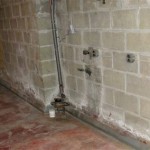Corner Basement Leaking Water from Ceiling: Identifying and Addressing the Problem
A leaking basement ceiling is a significant concern for any homeowner. Seeing water dripping from the ceiling can be alarming and raises immediate questions about the source of the leak and potential damage. While a leaky basement ceiling can be caused by various factors, a corner leak is a common issue. This article will explore the most common causes of corner basement leaks, provide guidance on identifying the root of the problem, and offer practical solutions for addressing the leak and preventing future occurrences.
Understanding the Cause of Corner Basement Leaks
Corner basement leaks are often attributed to factors that concentrate water flow in specific areas. Common causes include:
- Cracked Foundation Walls: Foundation walls are susceptible to cracking, especially in areas with significant temperature fluctuations, soil movement, or settling. These cracks can allow water to seep into the basement, particularly in corners where the foundation walls meet.
- Inadequate Waterproofing: Insufficient or compromised waterproofing around the foundation perimeter, including the basement corners, can lead to water infiltration. This can be a result of cracked or deteriorating waterproofing membranes, improper installation during construction, or damage caused by landscaping work or tree roots.
- Roof Drainage Issues: Improper roof drainage, such as clogged gutters or downspouts, can result in water overflowing and directed toward the foundation, accumulating in corners and seeping into the basement.
- Poor Landscaping: Improper landscaping practices, such as planting trees or shrubs too close to the foundation, can create pathways for water to flow towards the basement, concentrating the flow in corners.
- Window and Door Seals: Faulty window or door seals can permit rainwater or snowmelt to infiltrate the basement, particularly around corners where the walls meet the windows or doors.
- Condensation: In humid climates, condensation can form on cold basement walls, particularly in corners where the air circulation is poor. This condensation can eventually lead to water dripping from the ceiling.
Identifying the Source of the Leak
Pinpointing the exact source of the leak is crucial to determine the most effective solution. Here are some steps to help identify the source:
- Visual Inspection: Carefully inspect the exterior of the basement foundation for any visible cracks, gaps, or areas where water might be entering. Look for signs of soil erosion or pooling water near the foundation.
- Check Gutters and Downspouts: Examine gutters and downspouts for blockages, leaks, or misalignment. Ensure the downspouts are directed away from the foundation and extend at least 5 feet from the house.
- Inspect Window and Door Seals: Check window and door seals for signs of deterioration, gaps, or cracks. Ensure the seals are intact and properly sealed to prevent water infiltration.
- Interior Moisture Check: Examine the basement floor for signs of dampness or mold growth. Check the basement walls for discoloration or condensation. These indicators can help pinpoint the location of the leak.
- Water Testing: If you suspect a leak from a specific source, such as a pipe, consider testing the water for contaminants. This can help determine if the water leaking from the ceiling is contaminated and pose a health risk.
Addressing the Leak and Preventing Future Occurrences
Once the source of the leak is identified, it's essential to address the problem to prevent further damage and ensure a dry basement. Solutions might include:
- Foundation Repair: If cracks in the foundation walls are the cause of the leak, they need to be repaired professionally using appropriate techniques like polyurethane injection or epoxy.
- Waterproof Membranes: Applying a waterproof membrane to the exterior of the foundation, especially around the corners, can prevent water infiltration. This might involve using a liquid membrane, sheet membrane, or a combination of both.
- Drainage Improvements: Repair or replace clogged gutters and downspouts. Ensure proper grading around the foundation to direct water away from the house. Consider adding a French drain or other drainage system to divert water away from the basement.
- Landscaping Adjustments: Trim trees or shrubs that are too close to the foundation and create pathways for water to flow towards the basement. Avoid creating depressions in the ground near the foundation that can collect water.
- Window and Door Seal Replacement: Replace faulty seals around windows and doors with new, high-quality seals to prevent water infiltration.
- Basement Ventilation: Improve air circulation in the basement by installing a ventilation system or using fans to reduce the buildup of moisture and condensation.
Addressing a corner basement leak requires a comprehensive approach that involves identifying the root cause, addressing the problem professionally, and implementing measures to prevent future occurrences. By taking these steps, you can ensure a dry and safe basement environment for your home.

My Ceiling Is Wet And I Can T Find The Water Leak A J Restoration

Finding The Source Of A Basement Water Problem Energy Vanguard

Finding The Source Of A Basement Water Problem Energy Vanguard

Water Stain On Ceiling What It Means To Do Next

Water Damage In Your Ceiling Isn T Always Easy To Spot Servpro

Basement Water Leaks Can Come From Above Home Repair Advice Youtube

Water Damage In Your Ceiling Isn T Always Easy To Spot Servpro

How To Fix A Leaking Basement From The Inside Tips For Homeowners

How To Easily Find Where Your Basement Leak Is Coming From

Water Stain On Ceiling What It Means To Do Next







